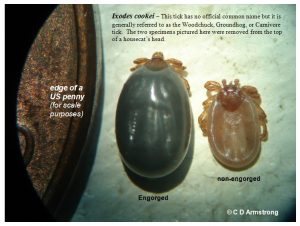Woodchuck Tick — Ixodes cookei

Ixodes cookei: These ticks, generally referred to as Woodchuck or Groundhog ticks, are very similar in appearance to deer ticks, so microscopic examination is required to most safely distinguish between the two species. Fortunately, unlike the case with deer ticks, woodchuck ticks have not been associated with Lyme disease transmission. It is not generally encountered nearly as often by people as are deer ticks and dog ticks, but it is the second most common species of the Ixodes genus tick found on people in Maine. Any household that has cats or dogs that are allowed outside may also encounter them because they can be inadvertently picked up and carried indoors (woodchucks, raccoons, rodents and other such mammals are hosts for these ticks, and they will feed on cats and dogs if given the opportunity). Adults or children who sleep with or cuddle with the cat or dog are thus at greater likelihood of finding one on themselves. Cats and dogs sometimes bring deer ticks into the home as well, of course, when visiting tick-infested areas.
The Minnesota Department of Health has posted information about a rare but dangerous virus called Powassan virus that can be vectored by this tick. Infection with Powassan virus can cause encephalitis (inflammation of the brain) and sometimes meningitis: Powassan Virus Disease
Additional Information and Photos from our Tick Lab: Woodchuck Tick
